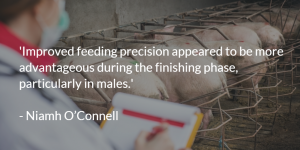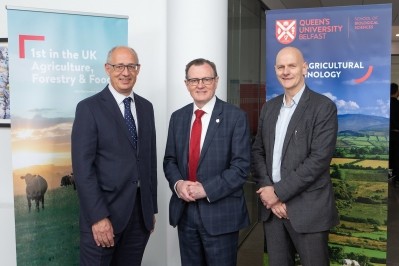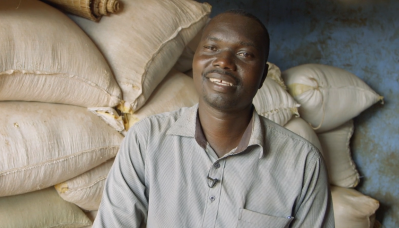Special Edition: Precision Feeding
‘We want to nail down the architecture of feed efficiency’ – EU funded research aiming for more sustainable pig and poultry farming
![The feeding of a nutrient deficient diet early in life to improve the efficiency with which the animal uses it in later stages could be an effective feed efficiency strategy for chickens. [pic (c) istock.com]](/var/wrbm_gb_food_pharma/storage/images/_aliases/wrbm_large/5/7/3/4/2144375-1-eng-GB/We-want-to-nail-down-the-architecture-of-feed-efficiency-EU-funded-research-aiming-for-more-sustainable-pig-and-poultry-farming.jpg)
Delegates at an ECO-FCE run dissemination forum in Poland in August heard how nutritional conditioning, the feeding of a nutrient deficient diet early in life to improve the efficiency with which the animal uses it in later stages, can be an effective feed efficiency strategy for chickens.
The ECO-FCE researchers had tested for phosphorous and methionine deprivation in young broiler chickens, explained Niamh O’Connell, strategic coordinator of the EU Framework 7 backed ECO-FCE initiative and also a reader at the Institute for Global Food Security (IGFS), Queen’s University Belfast.
“They found a tendency, but not a significant effect, for a positive impact of early phosphorous conditioning on weight gain and feed to gain ratio, and, interestingly from an animal welfare perspective, an improvement in bone mineralization. The team also saw that early methionine conditioning tended to improve feed to gain ratio in broilers fed a methionine limiting diet later in life,” she said.
The four year long project, which is now entering its third year, aims at improving the environmental impact of pig and poultry production without compromising animal welfare or productivity through evaluation of different feeding strategies.
“We want to nail down the architecture of feed efficiency,” O’Connell told FeedNavigator.
Precision feeding in pigs
In pig focused studies, she said the teams have been looking at how feed is offered, along with improved feeding precision strategies and liquid feeding.
Improved feeding precision in growing-finishing pigs by using more homogeneous groups of animals and up to nine feed compositions was evaluated compared to more conventional phase — two feed changes — and multiphase feeding — five feed changes.
“Improved feeding precision appeared to be more advantageous during the finishing phase, particularly in males,” said O’Connell.
Other trials found the use of exogenous enzymes in combination with liquid feeding and prolonged soaking of ingredients improved nutrient utilization in fattening pigs.
The team is also looking at the influence of certain enzymes when feeding pigs food processing by-products, said O'Connell.
There are 18 partner organizations in total in the ECO-FCE team with specialist expertise in the areas of monogastric nutrition, genetics, meta genomics, statistical modelling, product quality, animal production, and animal health and welfare.
The commercial partners include Devenish Nutrition, Cobb, Hermitage Genetics, and Delacon.
Gut bacteria profiling
The research is vast in its scope, she continued, with other ECO-FCE experts trying to get a thorough understanding of the interactions between the gut microbiome and host in monogastrics.
To this end, she said, they are investigating the gut bacterial profile, function and structure of pigs and broiler chickens in terms of good and poor feed efficiency (FE) and linking the changes in the gut bacterial profile to the modifications at structural and functional level of the gut.
In a research project led by Barbara Metzler-Zebeli, based at the University of Veterinary Medicine, Vetmeduni, in Austria, Elizabeth Magowan, from the Agri-Food and Biosciences Institute in Northern Ireland and Peadar Lawlor of Teagasc in Ireland, the functional potential of the intestinal microbiota of certain pigs and chickens is being looked at to elucidate the role of the intestinal microbiota in feed efficiency (FE).
In work already carried out, the team found both pigs and chickens with good FE showed greater mucosal permeability in the distal jejunum compared to animals of poor FE, with the effect being more pronounced in female chickens of good FE.
“While female chickens of good FE showed mainly shorter villus height and crypt depth along the small intestine, the main difference in gut structure in pigs were fewer goblet cell numbers in jejunum and cecum with good FE compared to poor FE.
At functional level improved carbohydrate digestion with good versus poor FE was indicated by enhanced disaccharidase activities at the duodenal brush border but only in pigs,” wrote the researchers in a paper for the forum in Poland.
The team is hoping to develop feeding strategies and additives that target key bacteria and gut functions to optimize monogastric production. They are currently trying to inoculate pigs and chickens with microbiota from good FE animals and feed prebiotics in an attempt to select for a microbial profile in the gastrointestinal tract so that good FE is promoted.
Another team is hoping to get insights into the genetics behind feed efficiency related traits, either by genome wide association studies (GWAS) or genomic selection (GS) approaches will provide links between genomic variation and variation in FCE and related growth, carcass and meat quality traits.
Web-based tools
O’Connell said, ultimately, the initiative is about developing tools and models to assist scientists and monogastric sector stakeholders in understanding, measuring and managing the impact of management decisions on FCE and environmental impact.
“At the outset, to avoid duplication of existing research, deputy ECO-FCE coordinator, Elizabeth Magowan, carried out a literature review of around 4,000 scientific papers.
She extracted data on all the relevant husbandry, nutrition, gut and genetic and environmental factors in relation to feed efficiency in monogastric production.
That has been collated in a spreadsheet format, and she is in the process of conducting a meta-analysis to add value to that data.
The objective is to transform the collated data into a searchable web based tool for industry stakeholders and scientists to leverage. One of our commercial partners, RTD Services, is tasked with that project,” said O’Connell.
















